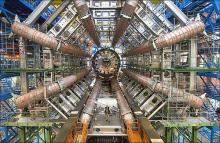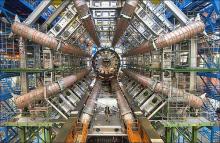God particle
If you’re like me you probably haven’t been following the latest scientific discussions about Higgs Boson (a.k.a. “the God particle"). But today I came across a 7-minute video in which Daniel Whiteson, a physicist at the prestigious European research organization CERN, walks through what the particle means, what it is, how it can be found (if it can be found at all).
But the best part about the whole discussion is that it is animated! The folks at PhD comics “a grad student comic strip,” break down the entire talk with clever visuals and an engaging presentation style.

The Higgs boson is perhaps better known by its sexier nickname: the "God particle."
But in fact, many scientists, including the physicist for whom it is named, dislike the term.
In 1993 when American physicist Leon Lederman was writing a book on the Higgs boson, he dubbed it "the goddamn particle." An editor suggested "the God particle" instead.
One thing is clear: The July 4 discovery that marked a new chapter in scientific knowledge also reignited debate over the universe’s origins — and the validity of religious faith as scientific knowledge expands.
The Higgs boson explains why particles have mass — and in turn why we exist. Without the boson, the universe would have no physical matter, only energy.
The cosmological implications are hotly debated. Can God fit in a scientific story of creation?

Physicists answer the question "What is the Higgs-Boson?"
In 1964, the British physicist Peter Higgs wrote a landmark paper hypothesizing why elementary particles have mass. He predicted the existence of a three-dimensional "field" that permeates space and drags on everything that trudges through it. Some particles have more trouble traversing the field than others, and this corresponds to them being heavier. If the field — later dubbed the Higgs field — really exists, then Higgs said it must have a particle associated with it: the Higgs boson.
Fast forward 48 years: On Wednesday (July 4), physicists at the Large Hadron Collider (LHC), the world's largest atom smasher in Geneva, Switzerland, announced they had discovered a Higgs-like particle at long last. If the new particle turns out to be the Higgs, it will confirm nearly five decades of particle physics theory, which incorporated the Higgs boson into the family of known particles and equations that describe them known as the Standard Model. (Source: LiveScience.com)
Still confused? (We are.) Inside the blog, four physicists explain on video.

It may have been buried in the bombastic July Fourth news cycle, but something amazing happened yesterday: scientists in Geneva have found the God particle.The Higgs boson, the elusive, “final puzzle piece” could help complete our current understanding of physics and supposedly explains why objects have mass.
And just cause scientists are really good at keeping people’s heartbeats low, let’s make sure we say they didn’t find it, but they “observed a new particle consistent with a Higgs boson” and are more than 99-percent certain that it is what they think it is.
Why is this a big deal?
It just is. If nothing else, it opens another conversation with scientists, Christians, and anyone who has ever wondered “why are we here?”
New particles don’t get found every day, you know? Link ahead to someone who knows a WHOLE lot more about this than we do. Here’s The Wall Street Journal’s take.
And for your amusement, a pretty infographic: Are you there, God? It’s us, scientists.

The international scientific community is excited about the growing possibility of discovering the so-called “God particle,” the spark they believe is the origin of the universe.
Despite the fact the Newt Gingrich has for many years claimed this title, physicists working at the Large Hadron Collider outside Geneva, Switzerland, apparently stopped appearing in Dan Brown novels long enough to come close to identifying this illusive particle. (Coincidentally, my college roommate’s car was called the Small Hadron Collider, a rusty Corvair with a habit of resisting the driver’s directional input at crucial moments, such as intersections.)
By the way, perhaps you’re wondering why unlocking the fundamental mysteries of the universe—such as Rick Santorum’s political career—and creating an enormous wealth of knowledge in experimental physics is not being done in the United States. It’s because President Bill Clinton chose to strip funding from the proposed collider outside Houston and instead funded the International Space Station, a rusty construction of old Corvair parts that has cost us over $150 billion and has provided little scientific discovery, unless you count the surprising effectiveness of duct tape in low gravity situations. To be fair, someday the Space Station will look really cool streaking across the sky just before it crashes onto somebody’s backyard. But I digress.